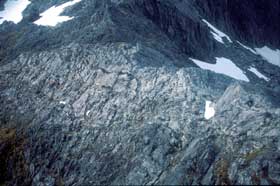Earth Sciences (also referred to as Geosciences), which deals with basic issues surrounding our planet, plays a vital role in the area of energy and raw materials supply.
Earth Sciences comprises subjects such as geology, geography, geological informatics, paleontology, mineralogy, petrography, crystallography, geophysics, geodesy, glaciology, cartography, photogrammetry, meteorology and seismology, early-warning systems, earthquake research and polar research.

Researchers trace flow over long distances
Researchers have discovered a pair of seamounts on the ocean floor that serve as inflow and outflow points for a vast plumbing system that circulates water through the seafloor. The seamounts are separated by more than 30 miles (52 kilometers).
“One big underwater volcano is sucking in seawater, and the water flows north through the rocks of the seafloor and comes out through another seamount,” said Andrew Fisher, an associate professor

NASA sponsored scientists have discovered by knowing the salt content of the ocean’s surface, they may be able to improve the ability to predict El Nino events. Scientists, studying the western Pacific Ocean, find regional changes in the saltiness of surface ocean water correspond to changes in upper ocean heat content in the months preceding an El Nino event. Knowing the distribution of surface salinity may help predict events.
Salinity and temperature combine to dictate the ocean’s dens

NASA and two Japanese government agencies are collaborating on a snowfall study over Wakasa Bay, Japan. Using NASA’s Earth Observing System Aqua satellite, research aircraft and coastal radars to gather data, the joint effort is expanding scientific knowledge about where precipitation falls.
Until now, the north Pacific’s contributions to the global hydrologic cycle have been difficult to quantify. Precipitation measurements by satellite over open water are very important, because

Analysis of Martian volcanoes will help determine when Hesperian epoch began
Research by a University at Buffalo planetary geologist suggests that generally accepted estimates about the geologic age of surfaces on Mars — which influence theories about its history and whether or not it once sustained life — could be way off.
Funded by the National Aeronautics and Space Administration, the research eventually could overturn principles about the relative ages of different are

Understanding how mountains form is critically important — from volcanic eruptions to earthquakes to catastrophic mudslides, the geologic processes active in mountain belts affect human societies every day. Yet, even though mountains are on all continents and in all ocean basins, scientists still understand relatively little about the forces that interact to form and destroy mountains, how mountains change over time, and the relationship between mountains and Earth’s climate.
To better

The discovery of 160 year old records in the archives of the Royal Society, London, has given scientists further evidence that Australian sea levels are rising.
Observations taken at Tasmania’s Port Arthur convict settlement 160 years ago by an amateur meteorologist have been compared with data from a modern tide gauge.
“There is a rate of sea level rise of about 1mm a year, consistent with other Australian observations,” says Dr David Pugh, from the UK’s Southampton Ocean